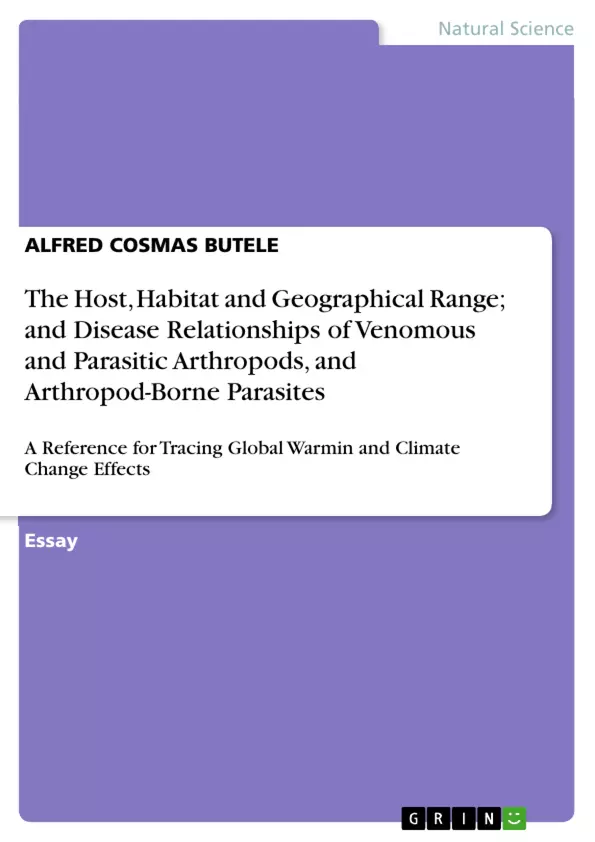Venomous arthropods are those that release a poisonous substance (venom) when disturbed. They release the venom in their defense against intruders. Examples of venomous arthropods are scorpions, wasps, some caterpillars and bees. The word “parasite” is derived from two Greek words, “para”, meaning “beside”, and “sitos” meaning “food”. Therefore, a parasite literally means an organism that is beside another organism for purposes of obtaining food. Adam, et al. (1979) defined a parasite as an organism which depends for part of its life or for its entire life on another organism, called the host, from which it obtains food and shelter. According to Smyth (1996), hosts are normally of a different species from their parasites. Parasitism is a kind of adaptation for survival, and in any case, a true parasite should not kill its host, lest it will kill its source of survival and/or kill itself too. Although many parasitic organisms are harmless to the host, others are pathogenic; they cause disease in their hosts, leading to morbidity and death of the host. The parasitic mode of life must have been a survival mechanism developed by certain organisms since the beginning of life on earth, about 4 billion years ago. It must have been impossible for these organisms to survive on their own. It is known that environment can change; presenting different conditions each time and organisms struggle to cope and survive with the change. We are aware that the earth has gone through periods of ice, fire, meteorite strikes, volcanic eruptions, global dust veils, acid rain, and continental upheavals. When such changes occur in the environment, organisms naturally take refuge in safer habitats, hosts or geographical locations. Better still, others change behaviour or transit through an evolutionary process into a new organism in order to fit within the new conditions. So, changes in the environment present with both challenges and opportunities. Organisms which were once free living can become parasitic and those which were once non-pathogenic can become pathogenic.
Table of Contents
- 1. INTRODUCTION.
- 2. DESCRIPTION.
- 3. GENERAL ANALYSIS..
- 4. ACTUALIZATION..
- The Host, Habitat and Geographical Range, and Disease Relationships of Venomous Arthropods......
- The Host, Habitat and Geographical Range, and Disease Relationships of Parasitic arthropods........
- The Host, Habitat and Geographical Range, and Disease Relationships of Arthropod-Borne Parasites.......
- The vector range of other arthropod borne pathogens and diseases..
- 5. DISCUSSIONS..
- 6. GENERAL RECOMMENDATIONS.
- 7. CONCLUSION..
- BIBLIOGRAPHY.
Objectives and Key Themes
This research paper aims to provide a comprehensive overview of the host, habitat, geographical range, and disease relationships of venomous and parasitic arthropods, as well as arthropod-borne parasites. The paper also explores how these relationships are affected by global warming and climate change.
- The role of arthropods in disease transmission
- The impact of climate change on arthropod populations and their interactions with humans
- The importance of understanding arthropod ecology for disease prevention and control
- The use of entomological research to trace the effects of global warming and climate change
- The need for ongoing research and monitoring of arthropod populations and their associated diseases
Chapter Summaries
- Introduction: This chapter provides a general overview of the topic, defining key terms such as venomous arthropods, parasites, and arthropod-borne parasites. It highlights the importance of understanding these relationships in the context of global warming and climate change.
- Description: This chapter provides a detailed description of different types of venomous and parasitic arthropods, including their life cycles, habitat preferences, and disease-causing abilities. It also discusses the various ways in which these arthropods interact with humans and other organisms.
- General Analysis: This chapter presents an analysis of the factors that influence the distribution and prevalence of venomous and parasitic arthropods, including climate, habitat, and human activities. It also discusses the ecological implications of these interactions.
- Actualization: This chapter focuses on the impact of global warming and climate change on the relationships between arthropods and humans. It examines how these changes are affecting arthropod populations, their geographic ranges, and the diseases they transmit.
- Discussions: This chapter presents a discussion of the key findings and implications of the research, highlighting the need for further research and monitoring of arthropod populations and their associated diseases.
Keywords
The key words and focus topics of this text include venomous arthropods, parasitic arthropods, arthropod-borne parasites, global warming, climate change, disease transmission, vector control, ecological relationships, entomological research, and public health.
- Quote paper
- ALFRED COSMAS BUTELE (Author), 2013, The Host, Habitat and Geographical Range; and Disease Relationships of Venomous and Parasitic Arthropods, and Arthropod-Borne Parasites, Munich, GRIN Verlag, https://www.hausarbeiten.de/document/208887


